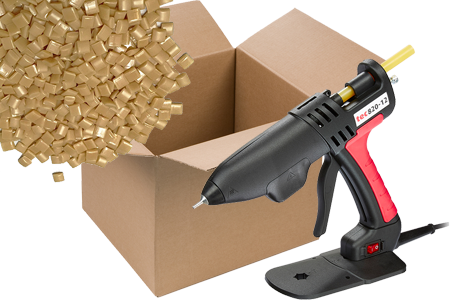Despite developments in the packaging industry and the number of economical options available for sealing packages, adhesive tapes are still a packaging staple for many companies and businesses. Because of the many varieties readily available in stores, adhesive tape is often used improperly, which can lead to frustrating outcomes for you or your customers. Avoiding these mistakes can help you maintain your company image and keep your customers happy.
1. Not Considering Your Other Adhesive Options
Depending on the job you are looking to complete, there may be better options for you than adhesive tape. In comparison with adhesive tapes, hot melt packaging could save you time and money. In fact, packaging with hot melt shaves seconds off packaging each item. This makes hot melt more economical, but, when you consider that packaging with hot melt also requires less product than packaging with adhesive tape, the savings are even more substantial.
For companies looking to assemble and ship thousands of packages every day, these seemingly slight differences in price and time make a huge difference for your bottom line. You may also need a stronger bond than adhesive tapes can offer. Packages sealed with hot melt hold more weight than those sealed with tape, and they simply stand up better under pressure. Because it can be run continuously and does not need to be stopped for a refill, hot melt also makes more sense for use in fast-paced assembly lines. Depending on your project, epoxy adhesives, super glue, or water-based adhesives may also be a better choice for you than adhesive tape.
2. Using the Wrong Tape

Tape is not a one-size fits all option, despite how often simple packaging tape is used for jobs it has simply not been developed for. Anyone who has ever tried to seal a box with bondage tape knows well the importance of having the right tape for the job. No other tape has the reinforcing properties that filament tape offers, for example, and there is no safe replacement for electrical wiring tape. Most adhesive tapes are readily available online, and you can easily eliminate the hassle and frustration of a poorly sealed package by planning ahead to ensure you have the right tape for your project.
3. Taping to Dirty Surfaces
Adhesive tapes are simply unable to adhere properly to surfaces that are coated with layers of dirt, dust, or oil. Additionally, adhesive typically does not cling well to hot, wet, or cold surfaces, or the surface of corrugated cardboard, which is typically too porous for adhesive tape to create a proper seal. Before utilizing adhesive tape, make sure the surface you are working with is clean and dry, so the tape can seal securely.
4. Using Old Tape
Approaching any job with old, unreliable, cheap, or shoddy materials is a bad idea. Packaging projects are no different. You certainly do not want to be sending poorly packaged products to your clients, as products can even become damaged or lost as a result. The typical shelf life for an adhesive tape that has been properly stored and kept out of the sun is one year. However, some tapes are of lower quality and will not last even this long. Check the shelf life on your tape’s packaging and replenish as needed.
5. Choosing the Wrong Tack
A tape’s level of tack refers to how quickly it is able to form a seal with a surface. In some cases, such as laying carpet, high-tack is necessary. However, in instances where the tape must be removed, high-tack adhesive tape can irreversibly damage the application surface. It can also leave frustrating, hard-to-remove residual marks on glass surfaces.
6. Not Thinking About the End Result

For companies that want to maintain a professional, clean look for their packaging, using large amounts of messily applied and wrinkly packaging tape can damage your company image. Double wrapping for added security not only looks bad, but it can also be frustrating for your customers to try to open. Packaging with hot melt not only makes for a stronger bond but a more attractive one as well.
7. Using Adhesive Tape in Extreme Environments
Extreme temperature changes can have detrimental effects on the tack and appearance of adhesive tape. Cold temperatures can cause the adhesive on the tape to stiffen, which will cause it to lose stickiness. Hot surfaces have the opposite effect, and they will make the adhesive softer. This allows the tape to slip from its original positioning and lose the strength of its bond. Whatever your adhesive needs, shifting away from relying on adhesive tapes for your sealing and packaging jobs may be the right step for you and your business.




